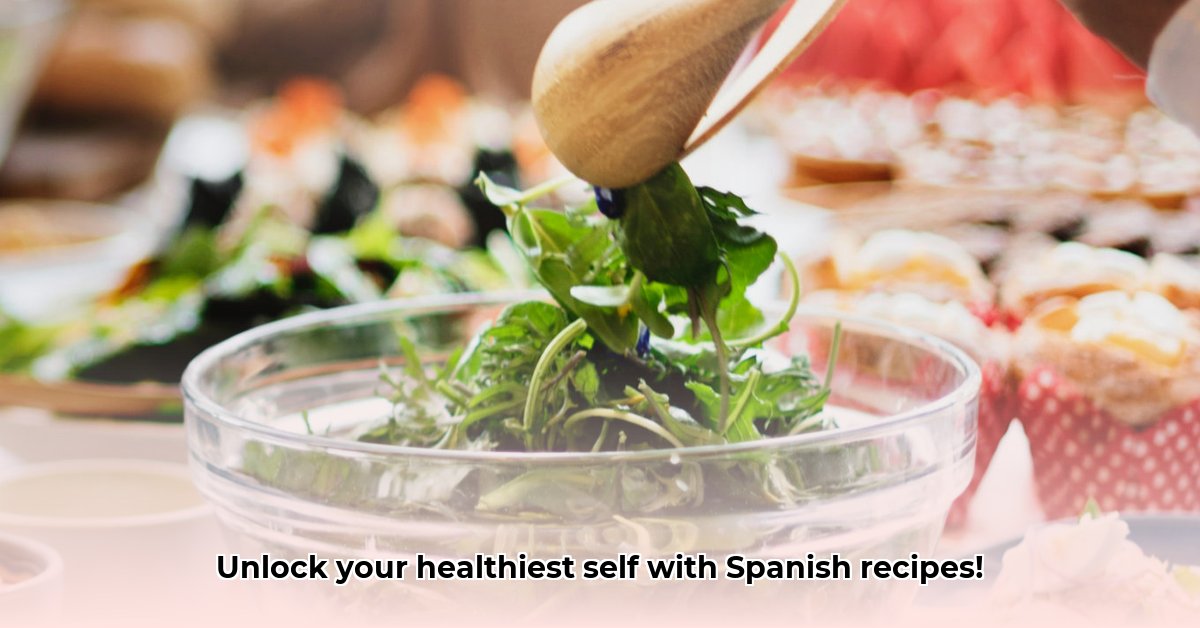¡A cocinar! This guide is all about eating well in a way that feels good and fits your life. We’ll explore healthy eating, comer saludable, in a way that respects your culture and traditions, showing you how to make delicious, nutritious meals with ingredients you already know and love. You’ll find easy-to-follow tips, tasty recipes, and encouragement to help you make lasting changes. Whether you want to know what makes a balanced meal, una comida balanceada, whip up some new recipes, or just add healthier choices to your daily routine, this guide is your friendly helper on the path to a healthier, happier you. For more extensive guidance, check out this helpful resource on healthy living: more tips here.
Eat Healthy in Spanish: Your Path to Wellness
Let’s embark on a journey to discover how to eat healthy within the rich tapestry of Spanish-speaking cultures. This isn’t just about translating words; it’s about understanding the heart of healthy eating within your own community and traditions. It’s about feeling amazing, energized, and full of life! We’ll explore practical steps, cultural nuances, and delightful recipes that will make healthy eating a joyful experience. Uncover the secrets to comida saludable and embrace a vibrant lifestyle filled with energy and vitality. Think of this not as a diet, dieta, but as a way of life, estilo de vida.
Understanding “Comida Saludable”: More Than Just Words
What does “eat healthy in Spanish” really mean? It’s more than just a direct translation. It’s about embracing a balanced lifestyle that respects your cultural heritage while boosting your overall well-being. Healthy eating looks different across the diverse Spanish-speaking world, but there’s a common thread: prioritizing fresh, whole, unprocessed foods. Think vibrant colors, exciting flavors, and dishes passed down through generations. “Comida saludable” encapsulates not only nutrition (nutrición) but also the cultural significance of food. It is about nurturing your body and soul.
Guiding Principles for a Healthier Lifestyle: Simple Steps, Big Impact
Forget complicated diets! The key to healthy eating is surprisingly simple:
- Balance Your Plate: Aim for variety. Imagine a colorful plate: a mix of vegetales (vegetables) and frutas (fruits), granos enteros (whole grains) like brown rice or quinoa, and proteínas magras (lean proteins) like chicken, fish, beans, or lentils. This variety ensures you’re getting a wide range of nutrients, nutrientes.
- Portion Perfection: You don’t have to starve yourself! Simply be mindful of your serving sizes, porciones. Use smaller plates – it tricks your brain into thinking you have more food than you actually do! Mindful portion control, control de porciones, can be a powerful tool to achieve your health goals.
- Hydration is Key: Water, agua, is your best friend! Aim for plenty of water throughout the day. It helps your body function optimally and keeps you feeling full and energized. Sometimes, infusiones (herbal teas) can be a great substitute. Water not only hydrates but also aids in digestion and nutrient absorption.
Exploring Food Groups: Los Grupos de Alimentos – Your Allies in Good Health
Let’s delve into the major food groups and explore their delicious Spanish counterparts:
| Food Group | Spanish | Examples (and so many more!) | Why They Matter |
|---|---|---|---|
| Fruits | Frutas | Apples (manzanas), bananas (plátanos), oranges (naranjas), strawberries (fresas), mangoes (mangos), papayas (papayas), watermelon (sandía), grapes (uvas) | Packed with vitamins, antioxidants, fiber, and natural sugars, azúcares naturales. |
| Vegetables | Vegetales | Lettuce (lechuga), spinach (espinacas), broccoli (brócoli), tomatoes (tomates), peppers (pimientos), avocados (aguacates), zucchini (calabacín), carrots (zanahorias) | Essential vitamins, minerals, and fiber. Boost your immunity! They are low in calories and high in nutrients, making them ideal for a healthy diet. |
| Whole Grains | Granos enteros | Brown rice (arroz integral), oats (avena), quinoa (quinoa), corn (maíz), whole wheat bread (pan integral), barley (cebada) | Provide sustained energy and fiber for better digestion. They help regulate blood sugar levels and contribute to a feeling of fullness. |
| Lean Protein | Proteínas magras | Chicken (pollo), fish (pescado), beans (frijoles), lentils (lentejas), tofu (tofu), eggs (huevos), chickpeas (garbanzos) | Crucial for muscle building, repair, and overall health. They are essential for growth, development, and maintaining a healthy immune system. |
| Healthy Fats | Grasas saludables | Avocados (aguacates), olive oil (aceite de oliva), nuts (nueces), seeds (semillas) | Important for brain health, hormone production, and nutrient absorption. Choose unsaturated fats over saturated and trans fats. |
These aren’t just ingredients; they are the building blocks of a healthy and vibrant life! Did you know that incorporating a variety of vegetables into your diet can reduce the risk of chronic diseases by up to 30%? Further benefits include improved energy levels, better sleep quality, and enhanced mood.
Simple & Delicious Meal Ideas: Ideas de Comidas Simples – Easy Recipes for Busy Lives
Here are some simple, healthy meal ideas to get you started. Remember, feel free to adapt them to your tastes and what you have on hand!
- Breakfast (Desayuno): Oatmeal with fruit (Avena con frutas) – A quick, nutritious start to your day. Add cinnamon (canela) or a drizzle of honey (miel) for extra flavor. Consider adding nuts for extra protein.
- Lunch (Almuerzo): A big salad with grilled chicken or fish (Ensalada con pollo a la parrilla o pescado). Load it up with your favorite veggies for a light yet satisfying meal. Drizzle with olive oil and vinegar for a healthy dressing.
- Dinner (Cena): Brown rice with beans and vegetables (Arroz integral con frijoles y vegetales) – A hearty and flavorful meal packed with protein and fiber. Experiment with different beans and veggies! Add spices like cumin, paprika, and oregano for extra flavor.
Tackling Common Challenges: Real-Life Solutions for Healthy Eating
Let’s address the hurdles that can sometimes stand in the way of healthy eating:
- Limited Access to Healthy Foods: It’s true that healthy food can sometimes be expensive. However, prioritize affordable options! Beans, lentils, seasonal produce, and whole grains are usually budget-friendly. Plan your meals around what’s in season and shop at local markets for better deals.
- Time Constraints: We all lead busy lives! The secret is preparation, preparación. Prepare meals or components of meals in advance. Salads, soups, and even overnight oats are fantastic time-saving options. Consider batch cooking on the weekends.
- Cultural Preferences: Don’t feel like you need to completely overhaul your eating habits overnight! Gradually incorporate healthier options. Adapt your favorite traditional recipes to be a bit healthier – for example, using less oil or swapping refined grains for whole grains. Experiment with different herbs and spices to enhance flavor without adding unhealthy ingredients.
Cultural Nuances: Matices Culturales – Embracing Your Heritage
Healthy eating in Spanish-speaking cultures isn’t about rigid rules. It’s a celebration of balance, flavor, and tradition. Many traditional dishes are naturally healthy – think of the abundance of fresh produce and legumes in many Latin American cuisines. You can often tweak these recipes to make them even healthier without sacrificing deliciousness. How can traditional mole be tweaked to reduce added sugars without losing its authentic flavor? Consider using natural sweeteners like dates or stevia. Adding more vegetables to traditional dishes can also increase their nutritional value.
Your Journey to Wellness: A Personal Adventure
Remember, this is your journey to a healthier you. Be patient, celebrate even the smallest victories, and embrace the process. Healthy eating in Spanish – or any language – is about finding what works best for you, while respecting your heritage and enjoying the wonderful world of food! Find joy in the process of discovering new and healthy recipes.
How to Adapt Healthy Eating Advice for Spanish-Speaking Communities
Key Takeaways:
- Many Spanish-speaking communities face unique challenges in adopting healthy eating habits. Understanding these is crucial.
- Cultural sensitivity is key when providing nutrition advice. Simply translating materials isn’t enough; you must adapt the message.
- Effective strategies involve using visuals, familiar foods, and practical advice.
Understanding Cultural Nuances
Let’s talk about how to adapt healthy eating advice for Spanish-speaking communities. It’s not just about
- How Glass Bento Box Containers Make Meal Prep Easier - December 18, 2025
- Why Glass Boxes for Lunch Are Trending for Meal Prep - December 17, 2025
- Bento Box Glass Offers Practical, Eco-Friendly Meal Storage - December 16, 2025










